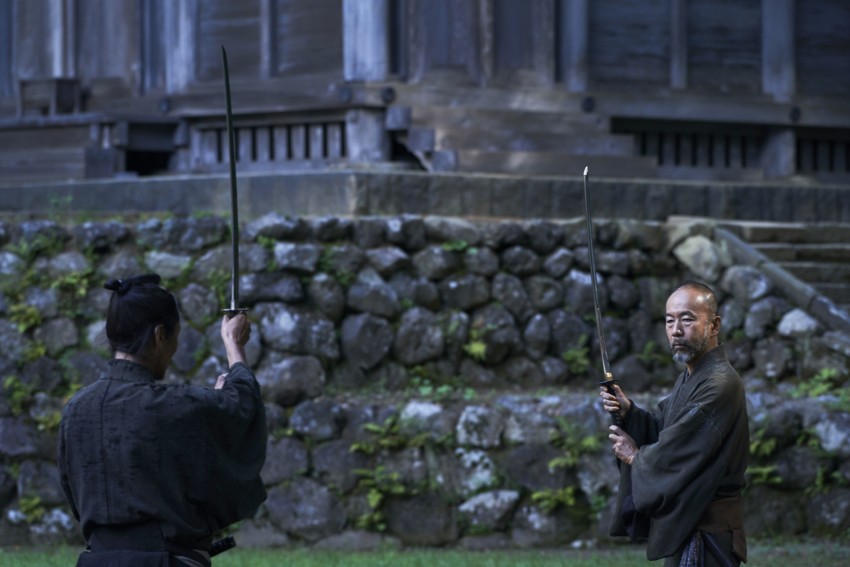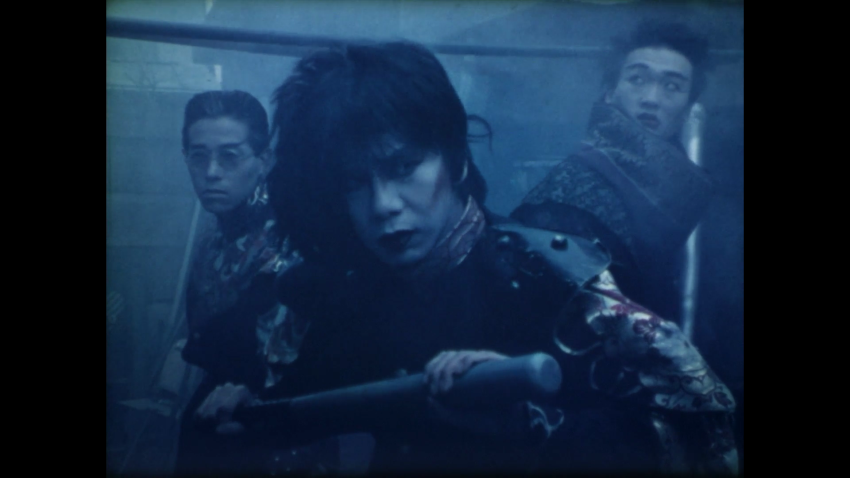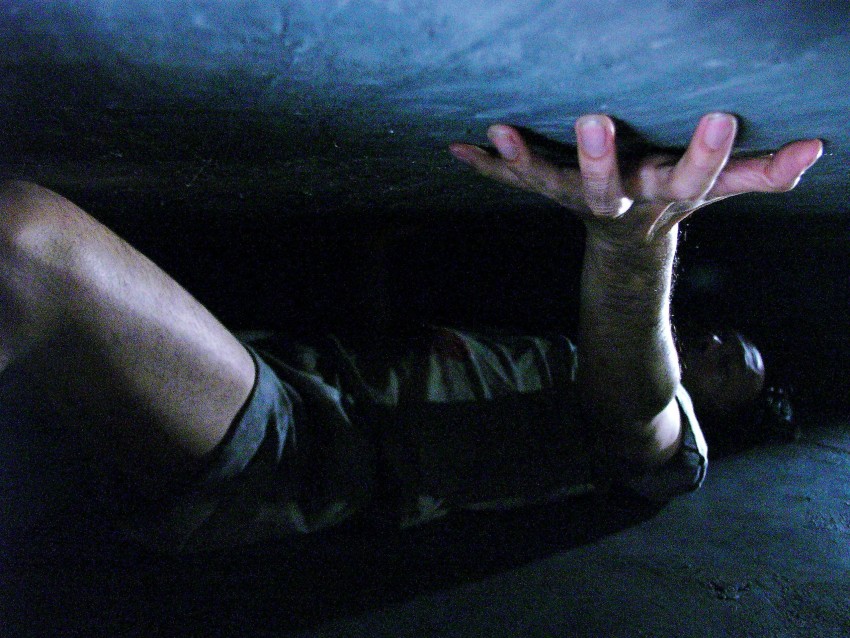Tsukamoto: Three Films
April 26, 2020 · 0 comments
by Jeremy Clarke.
 Shinya Tsukamoto’s latest feature, the samurai movie Killing comes to UK Blu-ray in a two-disc edition, along with two fascinating shorts: the Super-8 epic The Adventure of Denchu Kozo and the later masterpiece Haze. All three feature informative audio commentaries by Tom Mes, author of Iron Man: The Cinema of Shinya Tsukamoto (2005). The director is probably best known for cyberpunk epics Tetsuo: The Iron Man (1989) and its sequel/reboot Tetsuo II: Body Hammer (1992) which concern the fusion of flesh and metal into a new evolutionary human weapon form. His new film similarly explores the samurai and his metal blade becoming as one in a deadly human fighting machine.
Shinya Tsukamoto’s latest feature, the samurai movie Killing comes to UK Blu-ray in a two-disc edition, along with two fascinating shorts: the Super-8 epic The Adventure of Denchu Kozo and the later masterpiece Haze. All three feature informative audio commentaries by Tom Mes, author of Iron Man: The Cinema of Shinya Tsukamoto (2005). The director is probably best known for cyberpunk epics Tetsuo: The Iron Man (1989) and its sequel/reboot Tetsuo II: Body Hammer (1992) which concern the fusion of flesh and metal into a new evolutionary human weapon form. His new film similarly explores the samurai and his metal blade becoming as one in a deadly human fighting machine.
Killing. Tom Mes’s audio commentary sets the context for Japanese period films. By the 19th century, the samurai have been in charge for two centuries. Japan is cut off from the outside world, and the class structure begins to break down – the samurai warriors have effectively rendered themselves redundant, while the merchant class experiences leaps in prosperity. Foreign ships arrive, encouraging trade, but also challenging the authority of the ruling class. As the samurai struggle to deal with the foreign threat, the infamous Shinsengumi began to make a name for themselves as far-right bully-boys. Killing (2018) takes place amid these mid-19th-century upheavals. Mokunoshin (Sosuke Ikematsu) is a ronin (masterless samura) lodged in a woodland village providing it with protection. Staying with Yu (Yu Aoi), he trains her farmer brother Ichisuki (Ryusei Maeda) in fighting techniques using wooden rather than metal blades.
Two new disruptions upset village life. One is samurai Sawamura (director Shinya Tsukamoto himself) recruiting rural men for the Shinsengumi vigilantes. The other is a gang of ruffians, the leader of which (Tsukamoto regular Tatsuya Nakamura), picks on Ichisuki and has him beaten up, leading to a feud.
Killing is shot with Tsukamoto’s trademark reduced colour palette. Whereas Tetsuo was black and white and Tetsuo II alternates between yellow and blue, Killing’s overall palette consists of green laced with mud-grey. It’s more a drama than an action film, with scenes such as Sawamura’s initial routing of the gang merely reported, not shown. Tsukamoto’s interest lies in the samurai and his farmer trainee’s journeys of self-discovery. Our immersion in these characters render the film’s extended fight scenes all the more poignant when they finally arrive on the screen in the last half-hour.
 The Adventure of Denchu Kozo. In many ways a dry-run for Tetsuo, the 45-minute The Adventure of Denchu Kozo [Electric Pole Boy] (1987) is a film based on a play staged by the young Tsukamoto’s theatre group. It’s a time-travel movie about teenager Hikari (Nariaki Senba) with an electric rod sprouting from his back. Following his rescue from a gang of bullies (Shinya Tsukamoto, Tomorowo Taguchi, Mitsuru Saga) by sword-wielding girl Momo (Nobu Kanaoka), Hikari’s time machine propels him 25 years into the future where the Shinsengumi (!) gang of vampires (Tsukamoto, Taguchi, Saga again) have turned the sky black. They plan to wage war against humanity with a machine encasing the virginal Eve (Kei Fujiwara) which will go live once she reaches maturity – when she has her first period. However, before she does, so one vampire has sex with her, causing the machine to malfunction. Hikari and Miss Sulliva (Kanaoka again) must find and free Eve.
The Adventure of Denchu Kozo. In many ways a dry-run for Tetsuo, the 45-minute The Adventure of Denchu Kozo [Electric Pole Boy] (1987) is a film based on a play staged by the young Tsukamoto’s theatre group. It’s a time-travel movie about teenager Hikari (Nariaki Senba) with an electric rod sprouting from his back. Following his rescue from a gang of bullies (Shinya Tsukamoto, Tomorowo Taguchi, Mitsuru Saga) by sword-wielding girl Momo (Nobu Kanaoka), Hikari’s time machine propels him 25 years into the future where the Shinsengumi (!) gang of vampires (Tsukamoto, Taguchi, Saga again) have turned the sky black. They plan to wage war against humanity with a machine encasing the virginal Eve (Kei Fujiwara) which will go live once she reaches maturity – when she has her first period. However, before she does, so one vampire has sex with her, causing the machine to malfunction. Hikari and Miss Sulliva (Kanaoka again) must find and free Eve.
Propelled by its own energy and inventiveness Denchu Kozo belongs in the pixelated character continuum plotted by Norman McLaren’s classic Canadian anti-war animation Neighbours (1952) and Mike Jittlov’s The Wizard of Speed and Time (1979) in which the eponymous running magician covers whole countries and continents in seconds. Tsukamoto’s later Tetsuo would also use similar methods. Denchu Kozo’s vampires step onto strange, handmade-looking transport devices to race through the streets. The film also sits happily alongside shorts by the likes of the young David Lynch but also Czech surrealist Jan Švankmajer, who employs different live-action or animation techniques from shot to shot. Elsewhere, multiple glove puppet monsters burst out of Eve recalling Alien’s chest-bursting. It’s all very unreal – one might say hyperreal – and possesses unexpected charm.
 Haze. The 48-minute Haze (2005) comprises serial sequences of a man (Shinya Tsukamoto) waking in enclosed spaces, crawlspaces and narrow walkways bounded by concrete ceilings, floors and walls. On one occasion his teeth are fixed to a metal pipe along which he drags his mouth while the floor presents multiple upright nails point uppermost. On another, a sledgehammer repeatedly pounds his head though an opening. The narrative’s constructed hell evokes Jan Švankmajer’s terrifying, Edgar Allan Poe-inspired short The Pit, the Pendulum and Hope (1983) although the concrete gives Haze a distinctive, modern, urban feel.
Haze. The 48-minute Haze (2005) comprises serial sequences of a man (Shinya Tsukamoto) waking in enclosed spaces, crawlspaces and narrow walkways bounded by concrete ceilings, floors and walls. On one occasion his teeth are fixed to a metal pipe along which he drags his mouth while the floor presents multiple upright nails point uppermost. On another, a sledgehammer repeatedly pounds his head though an opening. The narrative’s constructed hell evokes Jan Švankmajer’s terrifying, Edgar Allan Poe-inspired short The Pit, the Pendulum and Hope (1983) although the concrete gives Haze a distinctive, modern, urban feel.
After a harrowing sequence of men crushed to death, leaving piles of bloody body parts, the man encounters a girl (Kaori Fuji from Tokyo Fist) determined to escape through the way she got in. The pair swim through submerged passages, past body parts floating in crimson water. When they eventually wake on the floor of a typical, compact Japanese apartment, the man goes out onto the rooftop to see a sunny cityscape, blue sky and hanging laundry evoking the end of 2001: A Space Odyssey’s scarcely comprehensible journey, where the astronaut arrives in a quasi-eighteenth century interior. Tsukamoto plants clues as to what might be going on.
Mes’ commentary posits a compelling interpretation relating to Buddhist concepts of karma, hell and reincarnation. Western viewers might also draw parallels with either the aforementioned Poe story or Franz Kafka’s novel The Trial, in which a man accused of an unknown crime must navigate confusing social and bureaucratic labyrinths in search of justice.
Haze’s intense experience proves more abstract than most Tsukamoto narratives. The teeth clamped around a metal pipe undeniably evoke Tetsuo. At the same time its theme of flesh pitted against concrete and metal fits alongside his wider body of work. Haze might just be Tsukamoto’s masterpiece.
Tsukamoto – Killing – Haze – The Adventures of Denchu Kozo is released on UK Blu-ray on 27th April.
Leave a Reply